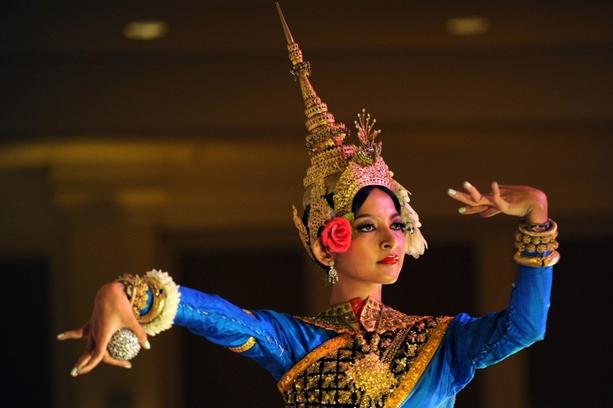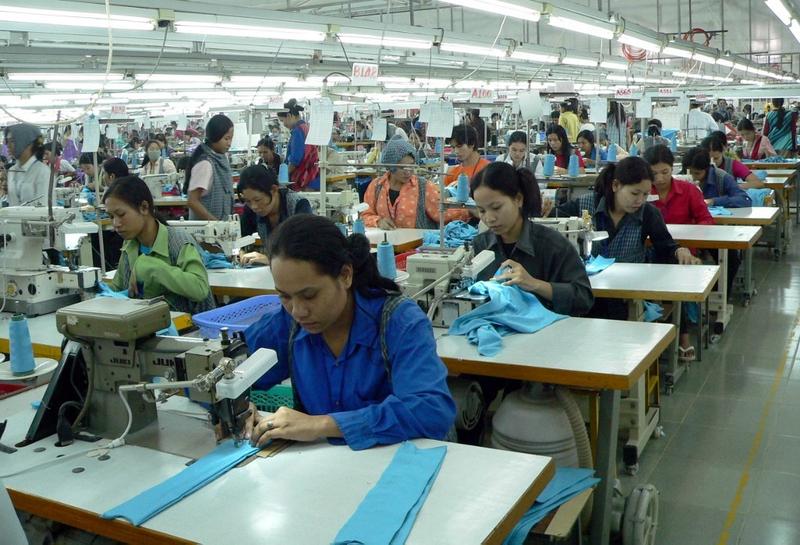 This photo taken on Dec 17, 2012 shows a Cambodian Apsara dancer performing during a ceremony at a hotel in Phnom Penh. (TANG CHHIN SOTHY / AFP)
This photo taken on Dec 17, 2012 shows a Cambodian Apsara dancer performing during a ceremony at a hotel in Phnom Penh. (TANG CHHIN SOTHY / AFP)
PHNOM PENH - The garment workers use the same fingers to pick up a needle that the mythical Apsaras bring thumb and index finger together in a gesture known as ‘falling fruit’ that helps them earn an income to support their families.
Just as the mythical Apsaras bring thumb and index finger together in a gesture known as ‘falling fruit’, so do garment workers use the same fingers to pick up a needle that helps them earn an income to support their families.
A new exhibition in Phnom Penh focuses on these garment workers, viewing them as today’s Apsaras.
The exhibition pays homage to the garment workers, the new Apsaras of Cambodia, the ones that hold the country together one stitch at a time.
Miguel Jeronimo, Photographer based in Phnom Penh, Cambodia
Opening on Feb 22 at The Plantation, The New Apsaras explores the ecological and social impact of the garment industry.
The exhibition is a critical and creative discussion on fashion, addressing the environmental impact of the fast fashion industry and the issue of mass overconsumption.
Miguel Jeronimo, a Phnom Penh-based Portuguese photographer and the event’s curator, told The Post that the aim is to creatively raise awareness, inspire and educate about the cheap unfair labor in Cambodia and how each individual can make a difference.
ALSO READ: Vietnam textiles workers struggle to get by on just US$50 a week
“Our goal is to educate people on the beauty of reusing, recycling and reclaiming old materials into works of art,” the artist said.
Jeronimo, who will be exhibiting his work at the event, points out that Cambodia’s biggest exports are garments, most of which are sold to fast fashion companies in Europe and the US.
About 700,000 workers, 90 percent of them women, are employed by the industry.
“However, those workers will never be able to afford the kind of clothes they make with their hands because they earn an average salary of US$183 per month. That’s how they support their families, with her fingers and a needle.
 Garment workers working at the Archid Garment Factory in Phnom Penh, Cambodia, March 5, 2005. (PORNCHAI KITTIWONGSAKUL / AFP)
Garment workers working at the Archid Garment Factory in Phnom Penh, Cambodia, March 5, 2005. (PORNCHAI KITTIWONGSAKUL / AFP)
“On the other hand, Apsaras are very prominent in Khmer culture.These semi-goddesses are dance masters and are considered a sign of fortune,” said Jeronimo.
Jeronimo said that one of Apsaras’ most iconic gestures is the way they press thumb and index fingers together and gently move their hand.
This is reminiscent of a tailor holding her needle, which, in this context, becomes a quasi-sacred movement that impacts the lives of millions.
“The exhibition pays homage to the garment workers, the new Apsaras of Cambodia, the ones that hold the country together one stitch at a time,” Jeronimo said.
One of Apsaras’ most iconic gestures is the way they press thumb and index fingers together and gently move their hand, reminiscent of a tailor holding her needle, which, in this context, becomes a quasi-sacred movement that impacts the lives of millions
READ MORE: Southeast Asia braces for change
Jeronimo, who is a prolific exhibitor, recently held an exhibition on Cambodia’s relation with waste.
His latest presentation, Jungle on My Mind, focused on portraits and close-ups of local tailors posing as Apsaras or making gestures inspired by the Royal Ballet of Cambodia.
The New Apsaras will feature other artists, local and international, working with different mediums.
In total, about 10 artists and organizations will be represented in the exhibition.
Jeronimo said humans are desperate for the latest piece and under immense pressure to keep up with current trends, leading companies to churn out new garments at an insane rate.
“The New Apsaras is an inspirational and educational fashion show introducing upcycled clothes, re-inventing one-of-a-kind pieces to show that garments deserve a second chance,” said Jeronimo.
“It is a funky, grunge collection made from scrap materials with a street-wear edge and gender-fluid feeling. One step at a time, we are shining the spotlight on one of the most polluting industries,” said Jeronimo.
Jeronimo said they started by visiting garment businesses with an ethical approach that gives employees good working conditions.
“For example, we visited Fairsew and interviewed some of the tailors to understand their stories. Some of them worked before in big factories and knew from the inside how hard the job is and for such low wages.
“From there, we slowly built up the event, with me talking to artists and inviting them to contribute to the exhibition and with Jaie preparing clothes with the students and diving deeper into ways to help the environment and the people when we buy and wear clothes,” said Jeronimo.


